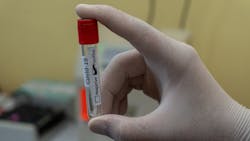Experts question CDC changes to COVID-19 testing guidance
Late Monday the Centers for Disease Control and Prevention (CDC) changed technical language on its website on who should get a COVID-19 test, a move that has baffled public health officials wrote Stephanie Soucheray for a Center for Infectious Disease Research and Policy (CIDRAP) News report.
"If you have been in close contact (within 6 feet) of a person with a COVID-19 infection for at least 15 minutes but do not have symptoms, you do not necessarily need a test unless you are a vulnerable individual or your health care provider or state or local public health officials recommend you take one," the guidelines now read, in contrast to the previous recommendation, which called for testing all close case contacts.
CNN broke the news that the decision to change the wording was made not by the CDC, but by top government officials from the Department of Health and Human Services (HHS), and could even reach the White House, where President Donald Trump has made clear he believes the United States is doing too much testing for the novel coronavirus.
For Patrick McConnon, MPH, who worked at the CDC for 39 years, the guideline's language is baffling. "This is atypical of any language I've seen coming from the CDC," McConnon told CIDRAP News. "I've never seen something so equivocating as, 'you do not necessarily need a test.' Well, what should someone do if they get a call from a contact tracer and are told they have been exposed?" McConnon said the language puts the decision-making process further down the line from the CDC and portrays testing case contacts as something that is up for discussion, or debate.
The change, made without any rationale or explanation, further erodes the scientific community's confidence in the CDC. For months, the story has been more—not less—testing could only help control the world's worst outbreak of the virus.
"If this is coming from HHS, it really undermines the CDC," said Amesh Adalja, MD, a senior scholar with the Johns Hopkins University Center for Health Security.
"I can think of no reason you wouldn't want people to access the test if they think there's good reason you need one," said Emily Gurley, PhD, an epidemiologist with the Bloomberg School of Public Health at Johns Hopkins. "If nationally the CDC were making the argument that we have to make this decision because of limited tests, that's one thing, but there's no evidence or real justification provided."
Both Adalja and Gurley said the new CDC language does not in any way alter the requirements of contact tracing, which state that all known case contacts should self-quarantine 14 days after an exposure. That recommendation holds, with or without testing.
"If you are deemed a significant exposure, you self-quarantine for 14 days," said Adalja. "A test only gives you an answer for one moment in time. A negative on day 6 doesn't mean you won't be positive for day 8."
Gurley agreed. "Some people make [the] mistake of thinking that if they get a negative [test] they don't have to quarantine," she said.
Though the change in language on testing does not change self-quarantine recommendations, experts are still concerned that the language moves the US backwards, and not forwards, in its fight against COVID-19.
Jeff Duchin, MD, the health officer for Public Health Seattle and King County, Washington, said he completely agrees that testing asymptomatic people who do not have an exposure to COVID-19 is not appropriate. But not testing known case contacts is another story. "Testing asymptomatic close contacts of COVID-19 cases is important to identify cases and interrupt transmission and we intend to continue to do that pending additional information that would lead us to reconsider," Duchin told CIDRAP News.
The U.S. reported 37,986 new COVID-19 cases, and 1,234 deaths, according to the Johns Hopkins COVID-19 tracker, bringing the national total to 5,824,189 cases and 179,756 deaths. Global cases are tat 24,206,817 with global deaths counted at 826,591.
